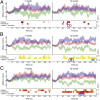Infants' brain responses to speech suggest analysis by synthesis
- PMID: 25024207
- PMCID: PMC4128155
- DOI: 10.1073/pnas.1410963111
Infants' brain responses to speech suggest analysis by synthesis
Abstract
Historic theories of speech perception (Motor Theory and Analysis by Synthesis) invoked listeners' knowledge of speech production to explain speech perception. Neuroimaging data show that adult listeners activate motor brain areas during speech perception. In two experiments using magnetoencephalography (MEG), we investigated motor brain activation, as well as auditory brain activation, during discrimination of native and nonnative syllables in infants at two ages that straddle the developmental transition from language-universal to language-specific speech perception. Adults are also tested in Exp. 1. MEG data revealed that 7-mo-old infants activate auditory (superior temporal) as well as motor brain areas (Broca's area, cerebellum) in response to speech, and equivalently for native and nonnative syllables. However, in 11- and 12-mo-old infants, native speech activates auditory brain areas to a greater degree than nonnative, whereas nonnative speech activates motor brain areas to a greater degree than native speech. This double dissociation in 11- to 12-mo-old infants matches the pattern of results obtained in adult listeners. Our infant data are consistent with Analysis by Synthesis: auditory analysis of speech is coupled with synthesis of the motor plans necessary to produce the speech signal. The findings have implications for: (i) perception-action theories of speech perception, (ii) the impact of "motherese" on early language learning, and (iii) the "social-gating" hypothesis and humans' development of social understanding.
Keywords: brain imaging; phonetic perception.
Conflict of interest statement
The authors declare no conflict of interest.
Figures



References
-
- Kuhl PK. Early language acquisition: cracking the speech code. Nat Rev Neurosci. 2004;5(11):831–843. - PubMed
-
- Saffran JR, Werker JF, Werner LA. In: in Handbook of Child Psychology. Lerner RM, Damon W, editors. Hoboken, NJ: Wiley; 2006. pp. 58–108.
-
- de Boer B, Kuhl PK. Investigating the role of infant-directed speech with a computer model. Acoust Res Lett Online. 2003;4(4):129–134.
Publication types
MeSH terms
Grants and funding
LinkOut - more resources
Full Text Sources
Other Literature Sources

